Trekking to the summit of Gunung Rinjani, Indonesia's second tallest volcano, is no small feat. But those who are in shape and looking for a change of pace from relaxing on the country's idyllic beaches will be treated to some truly fabulous views, other-worldly landscapes, and sore muscles for days afterward.
Gunung Rinjani National Park sits impressively on the northeastern end of Lombok, one major island east of Bali. Rinjani has been something of a trekking mecca for many years, and while business is certainly more steady now than it may have been a decade ago, the park is still massive enough that crowds are kept fairly thin.
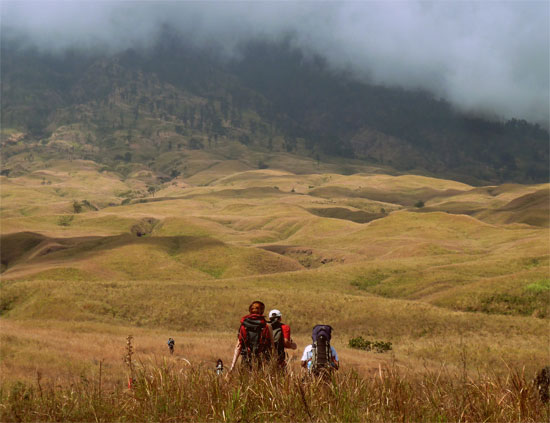
Early days, easy going.
The park itself boasts what seems to be an unlimited number of breathtaking vistas, fascinating ecological features, and some of the most difficult climbs any trekker could ask for.
Either side of Rinjani's massive crater lie sweeping golden grasslands and dense tropical rainforest, with the awe-inspiring crater lake poised in the middle of 360 degrees of volcanic alpine (topographical oxymoron?) beauty.
Rising from the eastern edge of the crater lake (Segara Anak) is a newer, active volcano cone, and behind it the impressive Rinjani summit, towering 3,726 metres above the nearby sea.
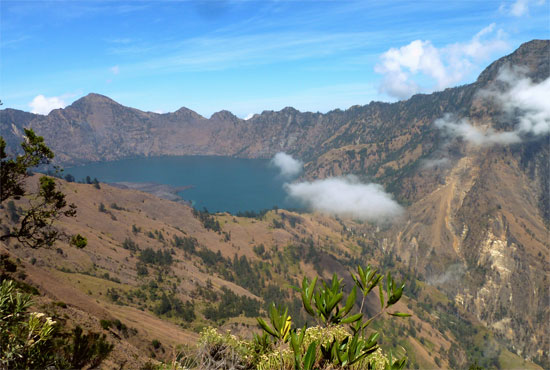
Crater lake - swim anyone?
Within the crater, just a short walk from the lake, is a series of hot springs, deep enough to swim in and said by locals to have healing powers. Rinjani is a veritable trekkers playground, and the type of place that can never quite be adequately described with words or pictures; you have to witness it firsthand to truly appreciate its rugged magnificence.
All this and more is reachable only by foot, and even then only by the truly determined foot. The hikes are extremely demanding, and will test even the fittest of travellers. Ascending to one of the two crater rims is always the first order of business, and many will feel as if they've had enough by the time they reach camp the first night, but the real adventurers will have just one goal in mind: The Summit.
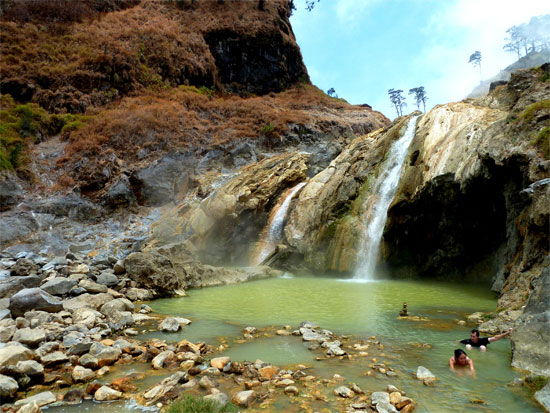
Hot spring distractions.
The hike to the Rinjani's summit is a gruelling three hours from the crater rim, going up through dusty, sandy slopes, to the rocky gravel rim path that leads up the side of the mountain to the summit.
The final 300 metres however is the most challenging section of the entire mountain, a steep incline of rocks and gravel that finds you sliding back a step for every two you take. The summit climb was easily the most strenuous and difficult activity I've ever undertaken while travelling, and perhaps simply one of the most physically taxing things I've ever forced myself to do; each time you look up to the summit you feel you're no closer than you were the previous 30 times you looked up.
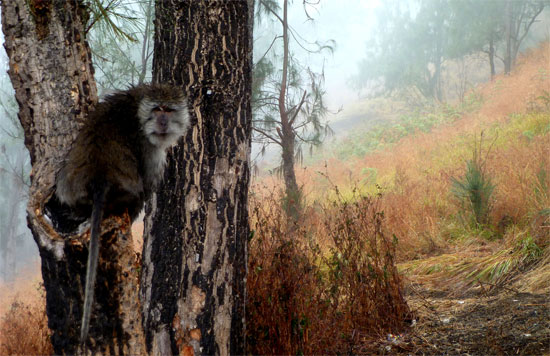
What are you doing here?
But while the hike is not for the faint of heart or the weak of will, those who push through the pain are rewarded with awe-inspiring sunrise views of the crater and all its features, Sumbawa to the east, the Gilis to the northwest, and, on especially clear days, you can even make out Bali's Gunung Agung. I thought I might die getting there, but the reward at the top was worth every step.
While a Rinjani trek can be the highlight of any trip to Indonesia, it should not be taken lightly. Those who are inexperienced at trekking or out of shape may find that they've bit off much more than they can chew, and will end up regretting their decision to make the journey. Merry-makers who came to Lombok for a tropical paradise getaway and packed their bags accordingly should realise that temperatures on the mountain plummet well below those on the nearby beaches, and lots of warm layers and solid footwear are an absolute must.
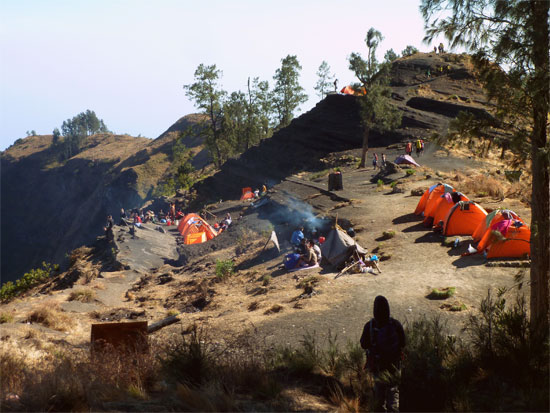
Camp 1 - Lux not.
Certainly, parents with children should seriously consider finding a babysitter before bringing their kids along, unless you've raised your children like mountain goats and they are well adapted to steep, cold, rocky terrain.
The trek is best undertaken in dry season from April through to November, and the park is usually closed to visitors in January and February.
Organising a Rinjani trek is easily done from anywhere on Lombok, and even Bali. Package trips can be arranged through many Bali travel agents, while the most direct tours can be booked from Padang Bai. As a word of caution, however, we have heard negative reviews of the quality of tours booked from Bali, and would advise getting a bit closer to the mountain before booking your tour. On the Gilis and Lombok itself, nearly every shop keeper and their dog will ask you to book a trek with them.
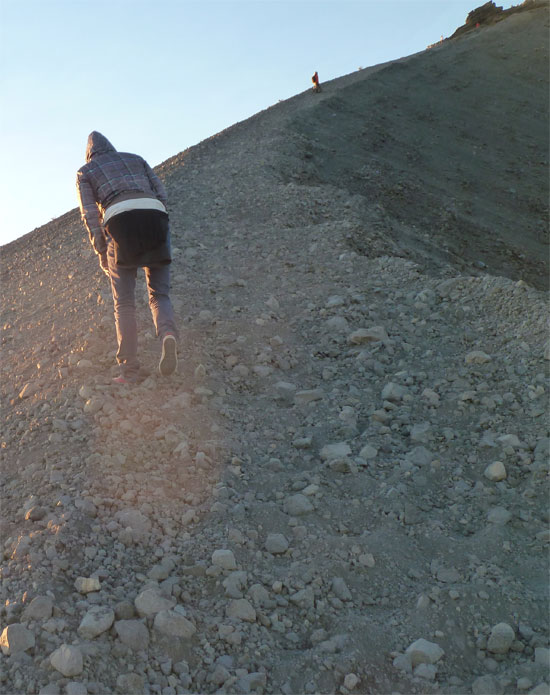
It's a long way to the top...
For those who want to go straight to the source, Senaru and Sembulan are the closest to the action, and essentially all tours pass through one or the other en route to the mountain. You may get a reduced price on your tour by booking in one of the two towns, but the cost and hassle of transport getting there may make it not worth the effort. Regardless of where you start, a guide and porters are a must, as tourists are not allowed access to the mountain without them.
Packages range from tours that spend only one night on the mountain through to treks that can last up to a week. Typically, most people book a three-day/two-night trek, which allows enough time (if only just... ) to reach the summit and see the most common sights along the way. However, if you have the time, a four- or five-day trek will allow you to get the most enjoyment out of the mountain without spending every minute of every day walking, eating or sleeping.
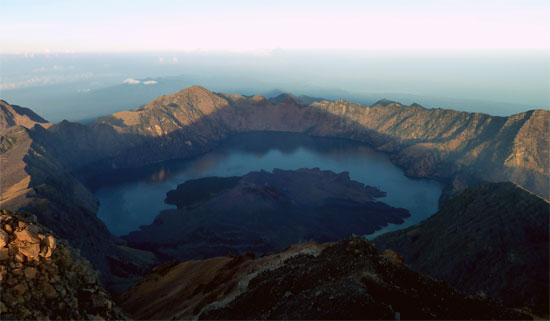
The view from the top.
Prices vary from organiser to organiser, though the cheapest prices we saw were surprisingly those on offer at the generic tourist shops/restaurants. Standard three-day/two-night treks run at about 1,200,000 rupiah on Lombok, and around 1,500,000 if booked on Gili Trawangan - though prices vary and discounts can be found if booking for several people. Because these tours are booked by third parties and then passed on to the operator, the quality of the experience can be variable, with few limits put on group size and sometimes questionable equipment. Though we did meet a backpacker who had nothing but good things to say about his Gili T-booked trek, not everyone has been so lucky.
Some may prefer to go with one of the more reputable companies, which was what I opted for. Specifically, I'd heard good things about the Rinjani Trekking Club in Senggigi, so I checked them out. Though their prices are higher, they maintain that the difference is justified through their service, both on and off the mountain. Once on the trek, my guide told me that they compensate their employees more responsibly than other operators, and they cap the number at a maximum of six people per group so they are manageable for porters and guides and the experiences are more intimate for guests. Three-day/two-night treks run right around $200, though you can pay more for a few added luxuries. Other reputed but pricey options include John's Adventure and Lombok Rinjani Trek Organisation.
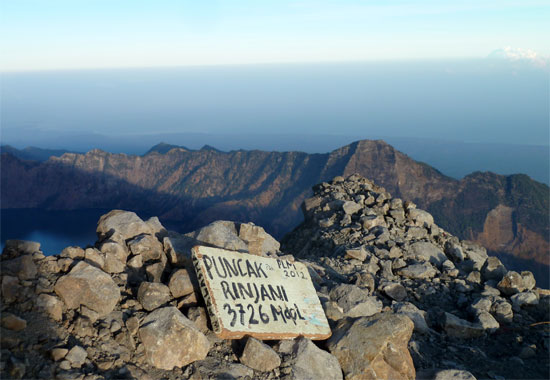
Made it!
When it comes down to making a choice, the sights are all the same and the trails just as steep no matter who takes you, so it mostly comes down to personal budget and expectations. The generic operators are the best choice for the budget-first crowd; however, those who are willing to spend a bit more to ensure their experience turns out as-advertised and the locals involved are treated well by their employer should try to book through the more reputable operators themselves.
Climbing Gunung Rinjani will present a challenge to even the most experienced, well-equipped trekker. However, if you've come to Indonesia looking for some exercise and an unforgettable experience, this trip might be the perfect thing - do make sure you reserve some time for recovery afterward on one of Lombok or Bali's pristine beaches.